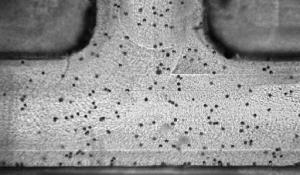
Understanding the behaviour of particles entrained in a fluid flow upon changes in flow direction is crucial in problems where particle inertia is important, such as the erosion process in pipe bends. We present results on the impact of particles in a T-shaped channel in the laminar–turbulent transitional regime. The impacting event for a given system is described in terms of the Reynolds number and the particle Stokes number. Experimental results for the impact are compared with the trajectories predicted by theoretical particle-tracing models for a range of configurations to determine the role of the viscous boundary layer in retarding the particles and reducing the rate of collision with the substrate. In particular, a two-dimensional model based on a stagnation-point flow is used together with three-dimensional numerical simulations. We show how the simple two-dimensional model provides a tractable way of understanding the general collision behaviour, while more advanced threedimensional simulations can be helpful in understanding the details of the flow.
Publications:
D. Vigolo, I.M. Griffiths, S. Radl, and H.A. Stone. An experimental and theoretical investigation of particle–wall impacts in a T-junction. Journal of Fluid Mechanics, 727: 236-255, 2013.
